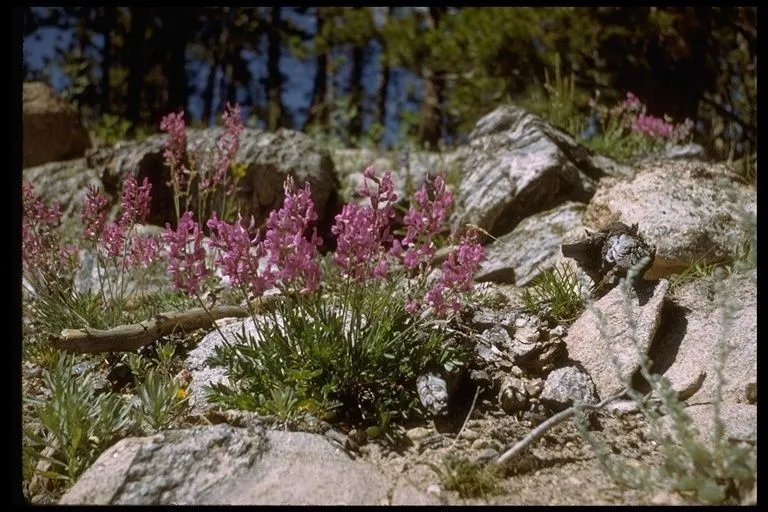
Author: Pursh
Bibliography: Fl. Amer. Sept. 2: 740 (1813)
Year: 1813
Status: accepted
Rank: species
Genus: Oxytropis
Vegetable: False
Observations: W. Canada to W. & C. U.S.A.
Purple locoweed, scientifically known as Oxytropis lambertii, is a captivating plant that falls within the Fabaceae family, which is renowned for its diversity and ecological significance. This perennial herbaceous plant owes its name, “locoweed,” to the toxic effects it can have on grazing animals, a well-documented trait of several species within its genus.
First described by Frederick Traugott Pursh in 1813, as noted in Fl. Amer. Sept. 2: 740, the plant has since been a subject of botanical interest. It is native to a broad range extending from western Canada through the western and central regions of the United States of America. This geographical span showcases its adaptability to various climates and terrains, from prairies to mountainous regions.
Typically, purple locoweed features vibrant, clustered purple flowers that distinguish it in the wild. These flowers are not only visually striking but play a crucial role in the plant’s reproductive process, attracting a variety of pollinators. The plant’s compound leaves are another distinctive feature, comprising numerous small, linear leaflets.
Ecologically, Oxytropis lambertii is significant for several reasons. It helps in nitrogen fixation, a critical process for soil health and fertility, typical of many members of the Fabaceae family. However, its toxicological impact on livestock, caused by the presence of swainsonine, a toxic alkaloid, requires careful management in areas where it grows abundantly.
In addition to its ecological and toxicological roles, purple locoweed also has potential applications in pharmacological research. The plant’s unique chemical compounds might offer insights into new therapeutic agents, though such use requires careful and comprehensive study.
In summary, Oxytropis lambertii presents a fascinating blend of beauty, ecological significance, and complexity. Its striking purple blooms, wide distribution, and dual role as both a beneficial nitrogen fixer and a potential hazard to livestock make it a plant worth observing and studying within its native habitat.
Eng: lambert’s crazyweed, lambert’s locoweed, locoweed, purple loco, purple locoweed, stemless loco, white woollyloco, whitepoint locoweed, stemless locoweed, stemless point-vetch
Swe: prärievedel
Fra: oxytrope de lambert
En: Purple locoweed, Lambert’s crazyweed, Lambert’s locoweed, Locoweed, Purple loco, Stemless loco, White woollyloco, Whitepoint locoweed, Stemless Locoweed, Stemless Point-vetch
Fr: Oxytrope de Lambert
Sv: Prärievedel
Taken Aug 11, 2019 by Clover Love (cc-by-sa)
Taken May 16, 2022 by Joseph Littlehorn (cc-by-sa)
Taken Aug 18, 2021 by Barb T (cc-by-sa)
Taken Jun 22, 2019 by James James Lopez (cc-by-sa)
Taken May 18, 2022 by Christiana Beaudin (cc-by-sa)
Taken Jul 4, 2014 by EOL − paloma (cc-by-nc)
Taken Nov 7, 2022 by Tracy Demers (cc-by-sa)
Taken Aug 18, 2021 by Barb T (cc-by-sa)
Taken Jun 7, 2000 by EOL − Gladys Lucille Smith (cc-by-nc-sa)
Taken Feb 18, 2001 by EOL − Robert Potts (cc-by-nc-sa)
Taken Dec 3, 2013 by EOL − Daniel Carter (cc-by-nc)
Taken Dec 17, 2015 by EOL − Sam Kieschnick (cc-by-nc)
Taken Feb 18, 2001 by EOL − Robert Potts (cc-by-nc-sa)
© copyright of the Board of Trustees of the Royal Botanic Gardens, Kew.
© copyright of the Board of Trustees of the Royal Botanic Gardens, Kew.
© copyright of the Board of Trustees of the Royal Botanic Gardens, Kew.
Growth form>: Single Crown
Growth habit>: Forb/herb
Growth rate>: Moderate
Ph maximum: 9.0
Ph minimum: 6.4
Family: Myrtaceae Author: (F.Muell.) K.D.Hill & L.A.S.Johnson Bibliography: Telopea 6: 402 (1995) Year: 1995 Status:…
Family: Rubiaceae Author: Pierre ex A.Froehner Bibliography: Notizbl. Bot. Gart. Berlin-Dahlem 1: 237 (1897) Year:…
Family: Sapindaceae Author: Koidz. Bibliography: J. Coll. Sci. Imp. Univ. Tokyo 32(1): 38 (1911) Year:…
Family: Asteraceae Author: A.Gray Bibliography: Pacif. Railr. Rep.: 107 (1857) Year: 1857 Status: accepted Rank:…
Family: Fabaceae Author: Medik. Bibliography: Vorles. Churpfälz. Phys.-Ökon. Ges. 2: 398 (1787) Year: 1787 Status:…
Family: Aspleniaceae Author: (Cav.) Alston Bibliography: Bull. Misc. Inform. Kew 1932: 309 (1932) Year: 1932…